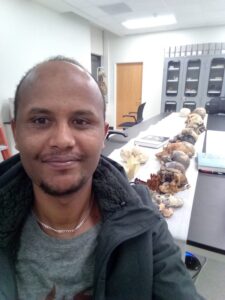Meet Our Wadsworth International Fellows: Weldeyared Reda
 The Foundation would like to introduce you to Weldeyared Reda, who recently received a Wadsworth International Fellowship to continue training in paleoanthropology at the University of Chicago, supervised by Dr. Callum Ross.
The Foundation would like to introduce you to Weldeyared Reda, who recently received a Wadsworth International Fellowship to continue training in paleoanthropology at the University of Chicago, supervised by Dr. Callum Ross.
Growing up in Ethiopia, I was fascinated by the many world-renowned paleoanthropological discoveries made there. This motivated me to pursue a BA in archaeology at Aksum and MSc in Paleoanthropology and Paleoenvironment at Addis Ababa Universities, both in Ethiopia. During my study, I have gained a great deal of research and field experience in the Afar Rift, the Blue Nile highways field school, and the Koobi Fora Field School. These hands-on experiences coupled with coursework in human evolution were instrumental in further strengthening my interest in human origins. My training also included a 5 month research visit to the California Academy of Sciences which was a great opportunity. Subsequent to completing my masters, I worked as a lecturer at Aksum University for two years.
The PhD program I have enrolled in at the Department of Organismal Biology and Anatomy at the University of Chicago is ideal to further my knowledge and skills in human evolution. The department’s focus on an integrative approach including human evolution, and the professors’ diverse expertise and in-house research facilities are some of the best in our field. The diversity of the faculty and the possibility to train or take relevant courses in the Departments of anthropology, human genetics and geosciences is also a great attraction.
My research aim is to expand our understanding of morphological character polarity by investigating their developmental underpinnings and functional significance, with a special focus on fossil hominins and great apes. Specifically, I am interested in the link between morphology and function in fossil hominins and great apes and associated developmental processes underlying morphological changes with implications for craniofacial development and function. I will investigate craniofacial ontogeny and function in Australopithecus afarensis and contemporaneous hominins within the context of the great apes and modern humans. This will be accomplished using cutting-edge imaging techniques and statistical methods.
After the completion of my study, I expect to return to Ethiopia and work at Aksum University. I have a keen interest to work in a multi-disciplinary paleoanthropological project and open new research avenues while paving the way for the next generation of paleoanthropologists.